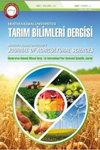Determination of L-dopa (L-3, 4-dihydroxyphenylalanine) content of some faba bean (Vicia faba L.) genotypes.
IF 1.1
4区 农林科学
Tarim Bilimleri Dergisi-journal of Agricultural Sciences
Pub Date : 2016-06-08
DOI:10.1501/TARIMBIL_0000001376
引用次数: 9
Abstract
Faba bean, reflecting all properties of legume crops such as soil improvement and benefit of human health, also contains L-dopa which can be used to cure Parkinson’s disease, is a rare plant. The study was conducted in Samsun province to determine the L-dopa content of leaf, flower and pod of faba bean genotypes. Four cultivars and 18 lines were sown on November in randomized complete blocks design with 3 replications. Samples were taken from leaves at vegatative period, flowers and fresh pods at generative period of faba bean. The L-dopa content was determined by HPLC. According to the result of variance analysis, the differences among genotypes for L-dopa content of flowers and fresh pods were found significant (P<0.01). L-dopa content of leaves, flowers and fresh pods varied between 10.88- 33.41, 40.95-96.37; 4.16-52.28 mg kg-1, respectively. L-dopa content of flowers of 20 genotypes, except a cultivar and a line, were found in same group statistically. Avarage L-dopa content of leaf, flower and pod of faba bean were 19.36, 75.87 and 25.27 mg kg-1, respectively. The most common form of consumption of faba bean in Turkey and treatmet for Parkinson’s disease in some countries is fresh pod. However this study showed that L-dopa amount in flower is higher (P<0.01) than that of leaf and pod. Results of this study revealed that L-dopa content of 7 lines were richer than that of others. If agronomic characters of 7 lines are well, their potential to become a new variety should be investigated.部分基因型蚕豆中左旋多巴(l - 3,4 -二羟基苯丙氨酸)含量的测定。
蚕豆是一种罕见的植物,体现了豆科作物改良土壤、有益人体健康等所有特性,还含有可用于治疗帕金森病的左旋多巴。本研究在三善省进行,测定了不同基因型蚕豆叶片、花和豆荚中的左旋多巴含量。11月播种4个品种18个系,采用随机完全区组设计,3个重复。分别从蚕豆生长阴期的叶片、繁殖期的花和鲜荚中提取样品。采用高效液相色谱法测定左旋多巴含量。方差分析结果显示,不同基因型间花和鲜豆荚的左旋多巴含量差异极显著(P<0.01)。叶片、花和鲜豆荚的左旋多巴含量分别为10.88 ~ 33.41、40.95 ~ 96.37;分别为4.16 ~ 52.28 mg kg-1。20个基因型花的左旋多巴含量除1个品种和1个品系外,在同一组中均有统计学差异。蚕豆叶片、花和豆荚中左旋多巴的平均含量分别为19.36、75.87和25.27 mg kg-1。在土耳其,最常见的蚕豆消费形式和一些国家治疗帕金森病的方法是新鲜豆荚。但本研究表明,花中左旋多巴含量高于叶和荚(P<0.01)。结果表明,7个品系的左旋多巴含量高于其他品系。如果7个品系的农艺性状良好,则应研究其成为新品种的潜力。
本文章由计算机程序翻译,如有差异,请以英文原文为准。
求助全文
约1分钟内获得全文
求助全文
来源期刊
CiteScore
1.40
自引率
0.00%
发文量
26
期刊介绍:
Journal of Agricultural Sciences (JAS) is an international, double-blind peer-reviewed, open-access journal, published by the Faculty of Agriculture, Ankara University. The journal invites original research papers containing new insight into any aspect of Agricultural Sciences that are not published or not being considered for publication elsewhere. Preliminary, confirmatory or inconclusive research, review articles, case and local studies and works presenting taxonomy will not be published.

 求助内容:
求助内容: 应助结果提醒方式:
应助结果提醒方式:


